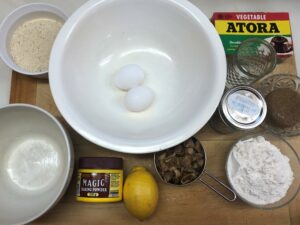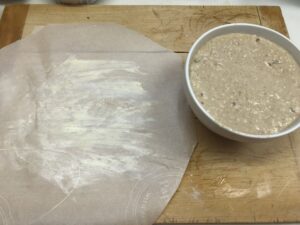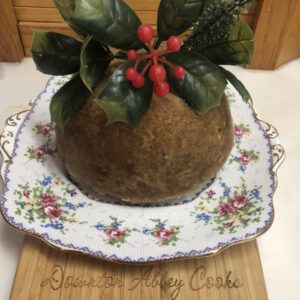For many, Holiday traditions include gathering to sing Christmas carols, many dating back to the Victorian-era. Have you ever been curious about “figgy pudding” which carolers demand in “We Wish You a Merry Christmas?”
With its rich medley of dried fruits, warm spices, and often a good splash of rum or brandy, figgy pudding is a dessert that evokes the very spirit of the season. But where did this sweet, steamed confection originate from? Read on for a bite of history along with the enjoyable flavors of this festive favorite.
Figgy pudding has its beginnings in Medieval England. Also referred to as plum pudding or Christmas pudding, the earliest versions were a porridge-like concoction of dried fruits and vegetables along with ale or wine to moisten it. This hearty mixture was often the first course of a meal, meant to fill bellies and satisfy appetites. Over time as ingredients became more available, dried fruits like raisins, currants, prunes took center stage along with suet for richness and eggs to bind it together. Spices brought back from foreign trade routes gave depth of flavor and by the Victorian era, figgy pudding resembled the treat we know today, doused in brandy and set aflame for a dazzling holiday spectacle.
Biting into figgy pudding is a true treat for the senses. The texture is moist and dense with a complex medley of tastes and aromas. It offers sweetness from brown sugar, molasses and dried fruits that mingle with warming spices like cinnamon, nutmeg, cloves and ginger. Bright hits of citrus from orange and lemon zest cut through the deep, darker notes. Combined with the rich mouthfeel from egg yolks and suet, every spoonful satisfies with layers of flavor. The age-old addition of brandy, rum or other spirits adds a subtle boozy background. All together, it’s a comforting symphony for the palate and the essence of holiday in dessert form.
Part of what makes figgy pudding so enjoyable and nostalgic is the tradition behind it. Not only is it fun to flambé the pudding before serving, but many families make it weeks in advance to allow the flavors to meld. The pudding “matures” and takes on more complexity, much like a fruitcake. Custom also dictates stirring the batter each week leading up to Christmas and including symbolic trinkets like coins for wealth, a thimble for thrift and a ring to signify romance. Whoever finds these prizes in their slice can look forward to a lucky new year!
So as you nibble cookie after cookie this season or nosh on nuts and candy canes, leave a little room for this time-honored treat. With a pedigree stretching back centuries and an intriguing evolution of ingredients and prep, figgy pudding is the embodiment of holiday tradition on a spoon. Dense, fruity, aromatic and infused with spice and spirit, each bite hearkens back to Christmases past while sparking sweet anticipation of celebrations to come. This year, be sure to leave out not just a cookie for Santa, but a hearty helping of this festive favorite!
This version has been adapted from Great British Puddings, with figs as the star ingredient. It is a lighter pudding than plum and you don’t need to make it well ahead of time. If you don’t have suet, shredding cold vegetable shortening will give you similar results.
Bring us some Figgy Pudding
Equipment
Ingredients
- 1 cup unbleached flour
- 1 pinch salt
- 1 cup bread crumbs
- 1 cup vegetable suet* shredded
- 1 tsp. mixed spice
- 1 tsp. baking powder
- 1/2 cup Dark brown sugar
- 1 cup figs chopped
- 1 large lemon finely grated
- 2 cups milk
- 2 large eggs beaten
- 2 tbsp. brandy
Instructions
- Grease a 4 cup pudding basin. Sift the flour and salt together into a large bowl then add all the remaining dry ingredients and mix to combine.

- Add the figs, lemon zest and juice, milk and eggs, and beat well. The mixture should reach a soft dropping consistency. Pour the mixture into the greased basin.
Prepare for Steaming
- Cut a large circle of parchment paper to cover the top of the pudding basin. Butter one side to prevent sticking.

- Place the buttered side down on top of the basin and secure with string.

- Add tin foil and press to hug the basin

- Using a large pot that the basin can fit in, place a metal jar lid on the bottom. Place the basin and fill halfway up the sides with boiling water. Cover with the lid and heat on the stove to simmer. Check the water level occasionally and top up with more water if needed. Simmer for three hours.
- Invert the pudding on a serving plate. Use artificial holly and berry sprig to decorate as really holly berries are poisonous. Serve with brandy butter, custard or just warmed golden syrup.
- If you are preparing the pudding in advance, steam as you did in cooking, but it will take 30 minutes or so get it warmed throughout.



